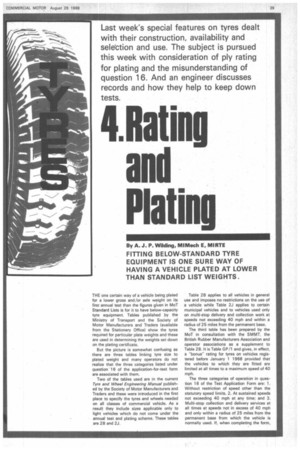4. Hating and Plating
Page 41

If you've noticed an error in this article please click here to report it so we can fix it.
THE one certain way of a vehicle being plated for a lower gross and /or axle weight on its first annual test than the figures given in MoT Standard Lists is for it to have below-capacity tyre equipment. Tables published by the Ministry of Transport and the Society of Motor Manufacturers and Traders (available from the Stationery Office) show the tyres required for particular plate weights and these are used in determining the weights set down on the plating certificate.
But the picture is somewhat confusing as there are three tables linking tyre size to plated weight and many operators do not realize that the three categories listed under question "16 of the application-for-test form are associated with them.
Two of the tables used are in the current Tyre and Wheel Engineering Manual published by the Society of Motor Manufacturers and Traders and these were introduced in the first place to specify the tyres and wheels needed on all classes of commercial vehicle. As a result they include sizes applicable only to light vehicles which do not come under the annual test and plating scheme. These tables are 2B and 2J.
Table 28 applies to all vehicles in general use and imposes no restrictions on the use of a vehicle while Table 2J applies to certain municipal vehicles and to vehicles used only on multi-stop delivery and collection work at speeds not exceeding 40 mph and within a radius of 25 miles from the permanent base.
The third table has been prepared by the MoT in consultation with the SMMT, the British Rubber Manufacturers Association and operator associations as a supplement to Table 2B. It is Table GP/1 and gives, in effect, a "bonus" rating for tyres on vehicles registered before January 1 1968 provided that the vehicles to which they are fitted are limited at all times to a maximum speed of 40 mph.
The three categories of operation in question 16 of the Test Application Form are: 1. Without restriction of speed other than the statutory speed limits. 2. At sustained speeds not exceeding 40 mph at any time; and 3. Multi-stop collection and delivery services at all times at speeds not in excess of 40 mph and only within a radius of 25 miles from the permanent base from which the vehicle is normally used. If, when completing the form,




































































































